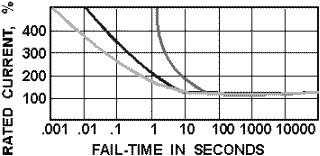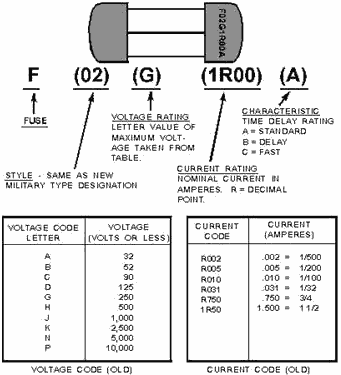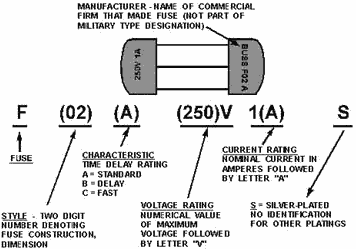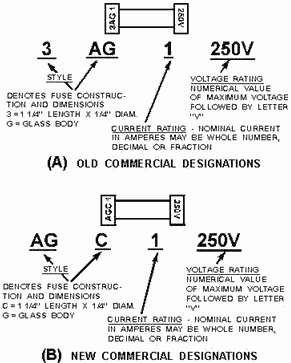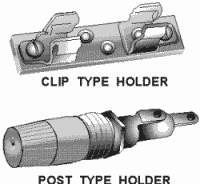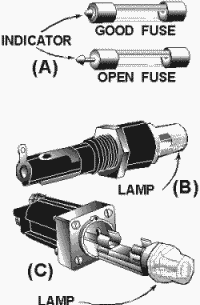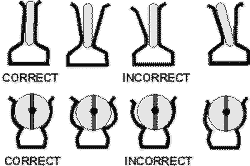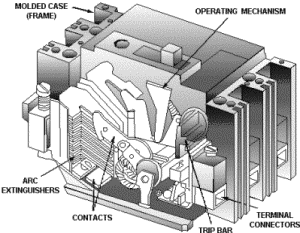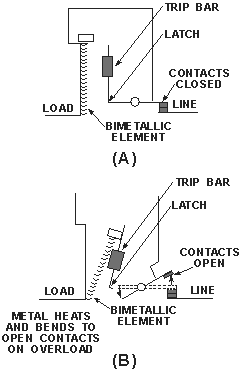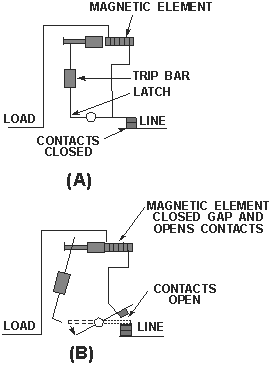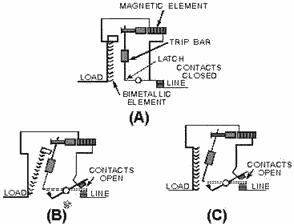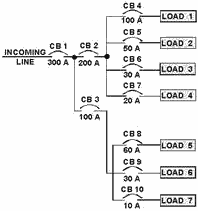Module 3 - Introduction to Circuit Protection, Control, and Measurement |
||||||||||||||||||||||||||||||||||||||||||||||||||
|
Module 3 −− Introduction to Circuit Protection, Control, and Measurement
Pages i, 1−1, 1−11, 1−21, 1−31, 1−41, 1−51, 1−61, 1−71, 2−1, 2−11, 1−21, 2−31, 2−41, 3−1, 3−11, 3−21, 3−31, AI−1, AII−1, AIII−1, IV−1, Index
The CURRENT RATING of a fuse is a value expressed in amperes that represents the amount of current the fuse will allow to flow without opening. The Voltage RATING of a fuse indicates the ability of the fuse to quickly extinguish the arc after the fuse element melts and the maximum voltage the open fuse will block. The TIME DELAY RATING of a fuse indicates the relationship between the current through the fuse and the time it takes for the fuse to open. The three time delay ratings for fuses are DELAY, STANDARD, and FAST.
DELAY FUses allow surge currents without opening. They are used to protect motors, solenoids, and transformers. STANDARD FUses have neither a time delay nor a fast acting characteristic. They are used in automobiles, lighting circuits and electrical power circuits. FAST FUses open very quickly with any current above the current rating of the fuse. They are used to protect delicate instruments or semiconductor devices. The OLD MILITARY FUSE DESIGNATION is a system of fuse identification that uses coding to represent the current, voltage, and time-delay rating of the fuse. New fuses purchased by the Navy will no longer use this designation. 2-31
The NEW MILITARY FUSE DESIGNATION is the system used to identify fuses purchased by the Navy at the present time. The coding of current and voltage ratings has been replaced with direct printing of these ratings. 2-32
The OLD COMMERCIAL FUSE DESIGNATION was used by the fuse manufacturers to identify fuses. The current and voltage ratings are printed on the fuse, but the time delay rating is contained in the style coding of the fuse. 2-33
The NEW COMMERCIAL FUSE DESIGNATION is currently used by fuse manufacturers to identify fuses. It is similar to the old commercial fuse designation with the difference being in the style coding portion of the designation. FUSE HOLDERS are used to allow easy replacement of fuses in a circuit.
2-34 The CLIP-TYPE has clips to connect the ferrules or knife blades of the fuse to the circuit. The POST-TYPE is an enclosed fuse holder. The center connection of the post type should be connected to the power source and the outside connector should be connected to the load. OPEN FUses can be found by VIsUAL INSPECTION, FUSE INDICATORS, or by the use of a METER. The following Safety PRECautionS should be observed when checking a fuse: • Turn the power off and discharge the circuit before removing a FUSE. • use a fuse puller when you remove a fuse from clip-type fuse holders. • When you check a fuse with a voltmeter, be careful to avoid shocks and short circuits. • When you use an ohmmeter to check fuses with low current ratings, be careful to avoid opening the fuse by excessive current.
REPLACEMENT FUses must be of the proper type. Check the technical manual parts list to find the identification of the proper fuse. If a substitute fuse must be used, the following guidelines should be followed: • Never use a fuse with a higher current rating, a lower voltage rating, or a slower time delay rating than the specified fuse. • The best substitution fuse is a fuse with the same current and time delay ratings and a higher voltage rating. 2-35 • If a lower current rating, or a lower time delay rating is used, the fuse may open under normal circuit conditions. Substitute fuses must have the same style (physical dimensions) as the specified fuse. PROPER FIT between the fuse and fuse holder is essential. If the clips on clip-type fuse holders are sprung, the clips should be reformed, or clip clamps should be used. Any corrosion on fuses or fuse holders must be removed with fine sandpaper.
PREVENTIVE Maintenance of fuses involves checking for the proper fuse, corrosion, proper fit, and open fuses; and correcting any discrepancies. Circuit BREAKERS have five main components: The frame, the operating mechanism, the arc extinguisher, the terminal connectors, and the trip element.
2-36 A THERMAL TRIP ELEMENT uses a bimetallic element that is heated by load current and bends due to this heating. If current (or temperature) increases above normal, the bimetallic element bends to push against a trip bar and opens the circuit.
A Magnetic TRIP ELEMENT uses an electromagnet in series with the load current to attract the trip bar and open the circuit if excessive current is present. 2-37
A THERMAL-Magnetic TRIP ELEMENT combines the thermal and magnetic trip elements into a single unit. a TRIP-FREE circuit breaker will trip (open) even if the operating mechanism is held in the ON position. a TRIP-FREE circuit breaker would be used on non-essential circuits.
A NONTRIP-FREE circuit breaker can be bypassed by holding the operating mechanism ON. A NONTRIP-FREE circuit breaker would be used for emergency or essential equipment circuits. 2-38 The TIME DELAY RATINGS of circuit breakers are INSTANTANEOUS, Short TIME DELAY, and Long TIME DELAY. SELECTIVE TRIPPING is used to cause the circuit breaker closest to the faulty circuit to trip, isolating the faulty circuit without affecting other non-faulty circuits. This is accomplished by using an instantaneous circuit breaker close to the load, a short time delay circuit breaker at the next junction, and a long time delay circuit breaker at the main junction box.
The Factors used to select a circuit breaker are the power requirements of the circuit and the physical space available. When Working ON Circuit BREAKERS, the following items should be done BEforE working on the circuit breaker: Check the applicable technical manual, obtain the approval of the electrical or engineering officer (for shipboard circuit breakers), remove power from the circuit breaker, and tag the switch that removes power from the circuit breaker. The following items should be checked and discrepancies corrected when working on circuit breakers: Check the operating mechanism for smooth operation, check the contacts for pitting, check the terminals for tightness and corrosion, check the mounting hardware for tightness and wear, check all components for wear, and check the entire circuit breaker for cleanliness. Answers to Questions Q1. Through Q43. A1. To protect people and circuits from possible hazardous conditions.
A2. a direct short, excessive current, and excessive heat.
A3. a condition in which some point in the circuit where full system voltage is present comes in contact with the ground or return side of the circuit.
A4. a condition that is not a direct short but in which circuit current increases beyond the designed current carrying ability of the circuit.
A5. a condition in which the heat in or around the circuit increases to a higher than normal level 2-39 A6. In series, so total current will be stopped when the device opens.
A7. Fuses and circuit breakers. A8. a. circuit breaker b. fuse.
A9. a. cartridge b. plug c. plug d. cartridge.
A10. A, C. A11. Current, voltage, and time delay.
A12. The amount of current the fuse will allow without opening.
A13. The ability of the fuse to quickly extinguish the arc after the fuse element melts and the maximum voltage that cannot jump across the gap of the fuse after the fuse opens.
A14. Delay, standard, and fast.
A15. Delay-Motors, solenoids, or transformers. Standard-Automobiles, lighting or electrical power circuits. Fast-Delicate instruments or semiconductor devices.
A16. a. 125 volts or less, 1.5 amperes, delay b. 250 volts or less, 1/8 ampere standard A17. a. 125 volts or less, 1/16 ampere b. 250 volts or less, .15 ampere
A18. F05B32V20A.
A19. a. Post-type fuse holder b. Clip-type fuse holder 2-40
|
||||||||||||||||||||||||||||||||||||||||||||||||||
